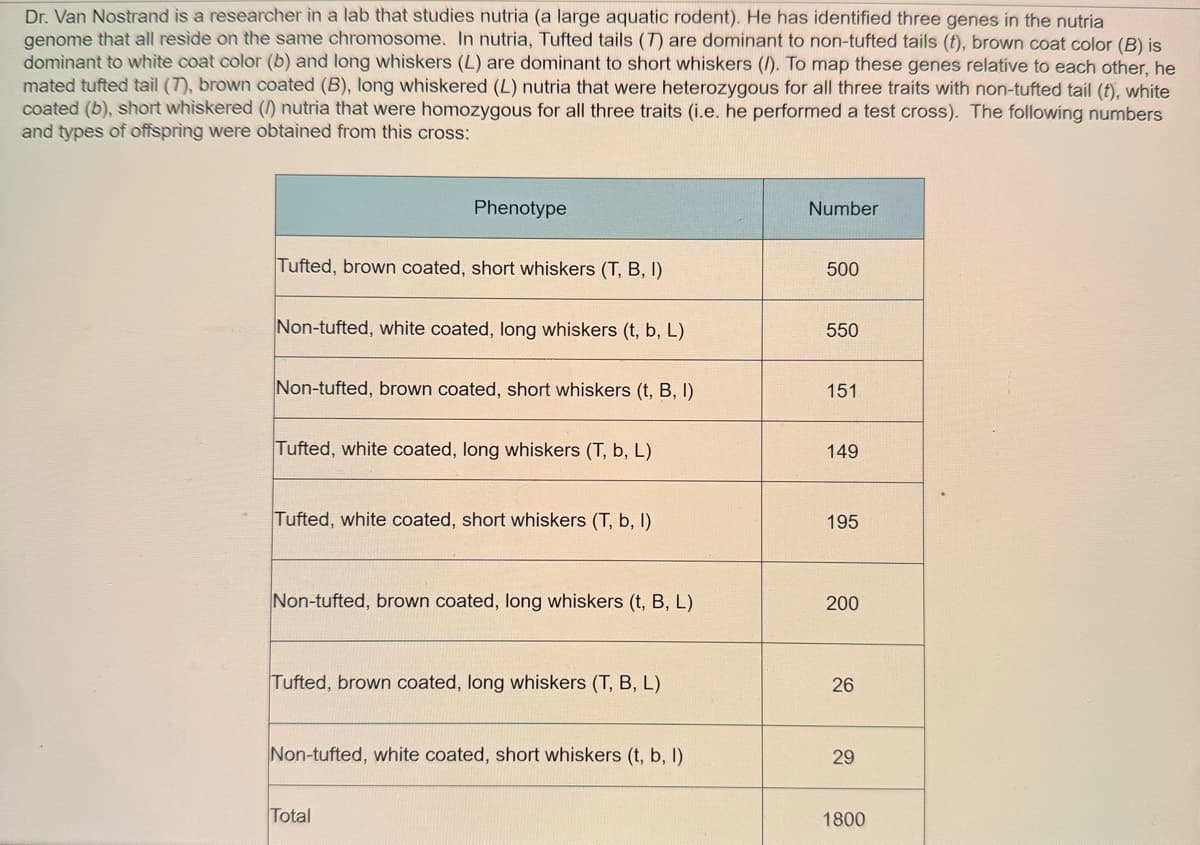Based on this data, which gene is in the middle? Give the distances in map units for each of the following gene pairs (please calculate your answer to the nearest hundreth of a map unit): T-B= B-L= T-L= Calculate the Interference (please calculate to 2 decimal places)
Based on this data, which gene is in the middle? Give the distances in map units for each of the following gene pairs (please calculate your answer to the nearest hundreth of a map unit): T-B= B-L= T-L= Calculate the Interference (please calculate to 2 decimal places)
Human Biology (MindTap Course List)
11th Edition
ISBN:9781305112100
Author:Cecie Starr, Beverly McMillan
Publisher:Cecie Starr, Beverly McMillan
Chapter20: Chromosomes And Human Genetics
Section: Chapter Questions
Problem 2CT: Human sex chromosomes are XX for females and XY for males. a. With respect to an X-linked gene, how...
Related questions
Question

Transcribed Image Text:Dr. Van Nostrand is a researcher in a lab that studies nutria (a large aquatic rodent). He has identified three genes in the nutria
genome that all reside on the same chromosome. In nutria, Tufted tails (7) are dominant to non-tufted tails (t), brown coat color (B) is
dominant to white coat color (b) and long whiskers (L) are dominant to short whiskers (/). To map these genes relative to each other, he
mated tufted tail (7), brown coated (B), long whiskered (L) nutria that were heterozygous for all three traits with non-tufted tail (t), white
coated (b), short whiskered (1) nutria that were homozygous for all three traits (i.e. he performed a test cross). The following numbers
and types of offspring were obtained from this cross:
Phenotype
Tufted, brown coated, short whiskers (T, B. I)
Non-tufted, white coated, long whiskers (t, b, L)
Non-tufted, brown coated, short whiskers (t, B, I)
Tufted, white coated, long whiskers (T, b, L)
Tufted, white coated, short whiskers (T,b,I)
Number
500
550
151
149
195
Non-tufted, brown coated, long whiskers (t, B, L)
200
Tufted, brown coated, long whiskers (T, B, L)
26
26
Non-tufted, white coated, short whiskers (t, b, I)
29
29
Total
1800

Transcribed Image Text:Based on this data, which gene is in the middle?
Give the distances in map units for each of the following gene pairs (please calculate your answer to the nearest hundreth of a map
unit):
T-B=
B-L=
T-L=
Calculate the Interference (please calculate to 2 decimal places)=
Expert Solution
This question has been solved!
Explore an expertly crafted, step-by-step solution for a thorough understanding of key concepts.
This is a popular solution!
Trending now
This is a popular solution!
Step by step
Solved in 3 steps with 3 images

Knowledge Booster
Learn more about
Need a deep-dive on the concept behind this application? Look no further. Learn more about this topic, biology and related others by exploring similar questions and additional content below.Recommended textbooks for you

Human Biology (MindTap Course List)
Biology
ISBN:
9781305112100
Author:
Cecie Starr, Beverly McMillan
Publisher:
Cengage Learning

Human Biology (MindTap Course List)
Biology
ISBN:
9781305112100
Author:
Cecie Starr, Beverly McMillan
Publisher:
Cengage Learning